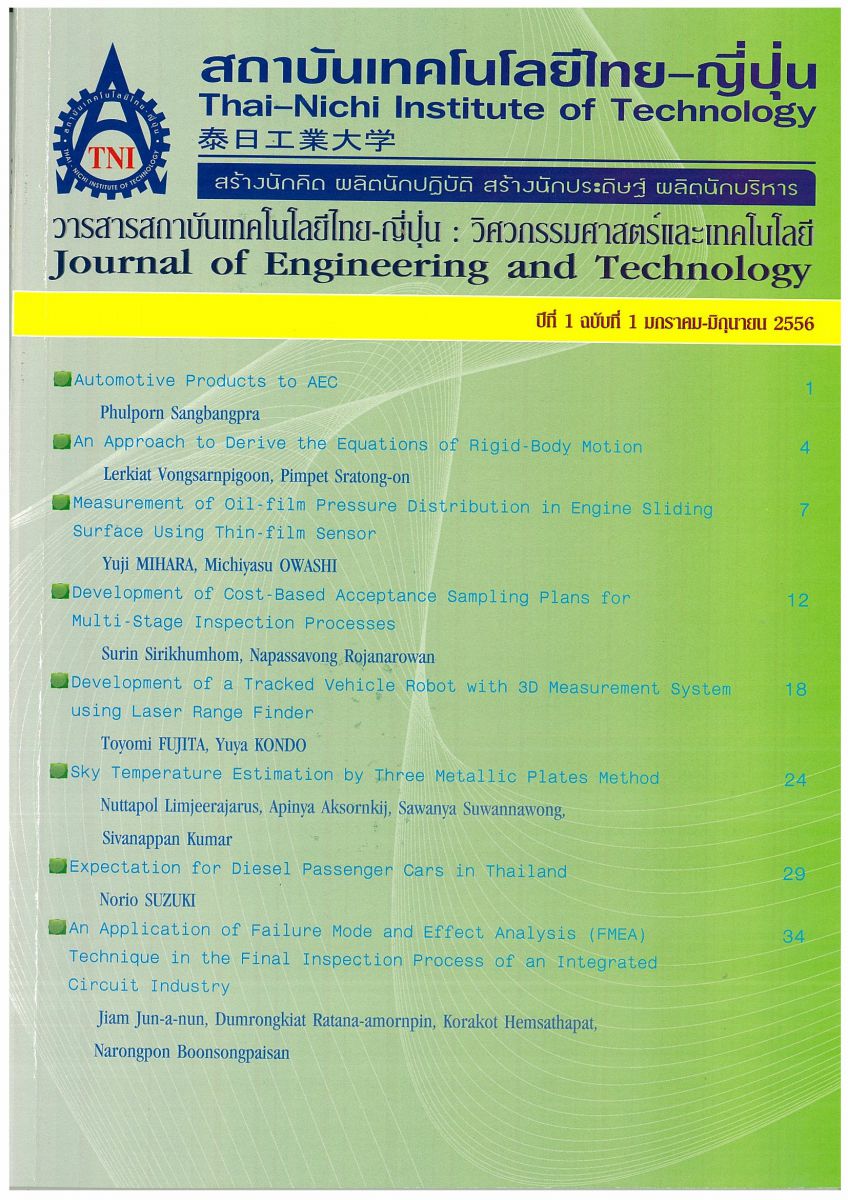Sky Temperature Estimation by Three Metallic Plates Method
Main Article Content
Abstract
Sky temperature (Tsky) is an important parameter used in the design of solar collectors and nocturnal cooling systems. Thus, correct estimation of the Tsky is essential. In this study, a novel three-metallic-plate (3MP) method has been proposed for the Tsky estimation in which a principle of different heat exchange rates between each metallic plate and the sky dome has been used. The 3MP method uses three aluminium plates coated with various coating materials, which have different absorptivities. By measuring ambient temperature, absorptivities and plate temperatures of each plate and then taking these parameters into account in energy balance equation, the Tsky can be estimated. The 3MP experimental results were used to develop a correlation of Tsky, which were compared with those obtained using pyrgeometer and correlations proposed in previous studies. The results showed that the correlation developed based on the 3MP method can satisfactorily predict the Tsky. Therefore, the 3MP method can be a useful alternative of the Tsky estimation, which has advantages of simplicity and less monetary requirement.
Article Details
Article Accepting Policy
The editorial board of Thai-Nichi Institute of Technology is pleased to receive articles from lecturers and experts in the fields of engineering and technology written in Thai or English. The academic work submitted for publication must not be published in any other publication before and must not be under consideration of other journal submissions. Therefore, those interested in participating in the dissemination of work and knowledge can submit their article to the editorial board for further submission to the screening committee to consider publishing in the journal. The articles that can be published include solely research articles. Interested persons can prepare their articles by reviewing recommendations for article authors.
Copyright infringement is solely the responsibility of the author(s) of the article. Articles that have been published must be screened and reviewed for quality from qualified experts approved by the editorial board.
The text that appears within each article published in this research journal is a personal opinion of each author, nothing related to Thai-Nichi Institute of Technology, and other faculty members in the institution in any way. Responsibilities and accuracy for the content of each article are owned by each author. If there is any mistake, each author will be responsible for his/her own article(s).
The editorial board reserves the right not to bring any content, views or comments of articles in the Journal of Thai-Nichi Institute of Technology to publish before receiving permission from the authorized author(s) in writing. The published work is the copyright of the Journal of Thai-Nichi Institute of Technology.
References
G. B. Smith, "Amplified radiative cooling via optimised combinations of aperture geometry and spectral emittance profiles of surfaces and the atmosphere," Solar Energy Materials and Solar Cells, vol. 93, pp. 1696–1701, 2009.
H. S. Bagiorgas and G. Mihalakakou, "Experimental and theoretical investigation of a nocturnal radiator for space cooling," Renewable Energy, vol. 33, pp. 1220–1227, 2008.
T. A. Reddy and P. Bouix, Solar Thermal Component and System Testing. Bangkok: Regional Energy Resources Information Center (RERIC), 1986.
N. Limjeerajarus, "Sky temperature estimation by three-metallicplate method," in Energy Field of Study: M. Eng. thesis, Asian Institute of Technology (AIT), Thailand, 2003.
R. W. Bliss, "Atmospheric radiation near the surface of the ground," Solar Energy, vol. 5, pp. 103–120, 1961.
G. Clark and C. P. Allen, "The estimation of atmospheric radiation for clear and cloudy skies," in Proc. 2nd Nat. Passive Solar Conf., 1978, p. 676.
P. Berdahl and G. Fromberg, "The thermal radiance of clear skies," Solar Energy, vol. 29, pp. 299–314, 1982.
J. Brau, "Temperature du ciel: Une mesure simplifiee," Climatique Sciences and Techniques, vol. 3, pp. 20–22, 1997.


